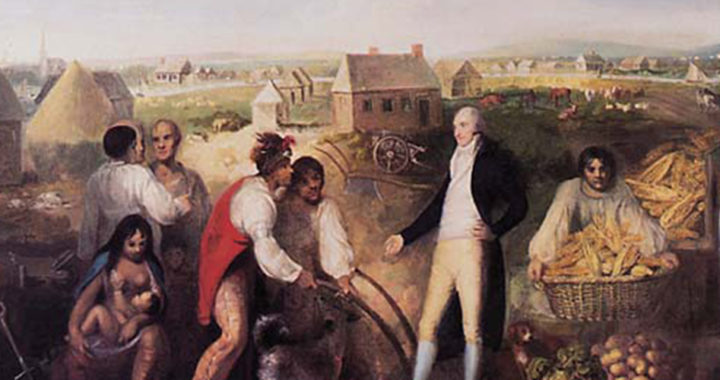The impact of manifest destiny to Native Americans was conflict. Of course, this was inevitable due to the fact that the ideology involved American settlers holding to a determined belief that they had a god-given purpose of expanding from the Atlantic coast to the Pacific coast, thus taking and controlling lands that were not originally theirs regardless of consequences.
The Impact of Manifest Destiny: How Did This Ideology Affect the Native Americans?
However, there were more specific consequences. One fundamental principle that formed the ideology was the Doctrine of Discovery. In 1823, the U.S. Supreme Court ruled in Johnson v. M’Intosh that this supposed international legal principle used by European colonizers was also applicable to the United States. Historians Robert J. Miller and Elizabeth Furse explained the implication of this ruling.
The doctrine stated that whenever European and Christian nations discovered new lands, the specific discovering country automatically gained sovereign and property rights over these territories held by non-European and non-Christian people despite the fact that these natives already owned, occupied, and used these lands.
According to the Supreme Court, when applied to the westward expansion of American settlers, the U.S. would acquire some sovereign rights over the native people and their governments that in turn, would restrict their tribal international political and commercial relationships. Take note that this apparent transfer of rights would transpire even without the knowledge of or consent from the Native Americans.
Below are the specific details of the consequences or impact of manifest destiny on Native Americans:
• Armed Conflict with the Settlers: Several wars transpired between the American settlers and the Native American tribes. One example was the Second Seminole War that happened between 1835 and 1842. It involved an armed conflict between different groups of Indians collectively called the Seminoles and the U.S. It resulted in the natives giving up their lands in Florida to the settlers and relocating in designated reservations.
• Displacement from Native Lands: In her reference handbook, Lorraine Hale mentioned that after the 1830s, the forcible removal of Native Americans from their homelands became commonplace. They were moved from reservations without taking into consideration whether these new lands were suited to their traditional way of life. Note that several Indian tribes moved further north and settled to territories in Canada.
• Exposure to Communicable Diseases: The arrival of Europeans in the Americas and the expansion of the American settlers exposed Native American populations to new infectious diseases. The review of K. B. Patterson and T. Runge noted that diseases such as measles and smallpox devastated these populations. It specifically noted that the arrival of smallpox correlated with the decline of Native American populations from the 15th to the 19th century.
• Reduction in the Number of Population: Estimates from Cherokee-American anthropologist Russell Thornton revealed that by 1800, the population of Native Americans in the U.S. numbered to about 600,000. However, by 1890, the population declined to 250,000. The population decline came from the warfare, diseases, and poverty introduced by the colonizers and settlers from the Old World. However, as noted in the study of J. D. Hacker and M. R. Haines, the further expansion of the settlers during the 19th century significantly reduced the numbers of Indians inhabiting the present-day U.S.
• Indoctrination and Assimilation: The federal government made several efforts to indoctrinate the Native Americans and assimilate them with the settlers. For example, as discussed by Laurence French, the Dawes Act of 1887 included provisions for special educational indoctrinations, including the mandatory use of English and the inculcation of patriotism in Indian schools. Furthermore, as noted in the paper of John Rhodes, the government also subjected them under religious persecution not only by grabbing their sacred lands but also by prohibiting them from exercising their religions.
FURTHER READINGS AND REFERENCES
- French, L. 2003. Native American Justice. Chicago, IL: Burnham Inc. Publishers. ISBN: 0-8304-1575-0
- Hacker, J. D. and Haines, M. R. 2005. “American Indian Mortality in the Late Nineteenth Century: the Impact of Federal Assimilation Policies on a Vulnerable Population.” Annales De Démographie Historique. 110(2). DOI: 10.3917/adh.110.0017
- Hale, L. 2002. Native American Education: A Reference Handbook. Santa Barbara, CA: ABC-CLIO. ISBN: 1-57607-363-8
- Miller, R. J. and Furse, E. 2006. “The Doctrine of Discovery.” Native America, Discovered and Conquered: Thomas Jefferson, Lewis & Clark, and Manifest Destiny. Westport, CT: Greenwood Publishing Group, Inc. ISBN: 0-275-99011-7
- Patterson, K. B. and Ringer, T. 2002. “Smallpox and the Native Americans.” American Journal of the Medical Sciences. 323(4): 216-222. PMID: 12003378
- Rhodes, J. 1991. “An American Tradition: The Religious Persecution of Native Americans.” Montana Law Review. 52(1): 14-35. Available online
- Thornton, R. 1990. American Indian Holocaust and Survival: A Population History since 1492. Oklahoma: Oklahoma University Press. ISBN: 0-8061-2220





